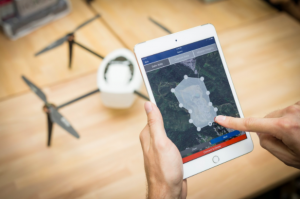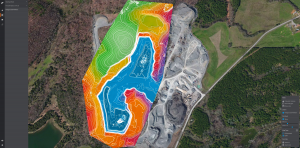 Sponsored Post by Rosalie Bartlett, Kespry. Large enterprises are adopting drone technology at an incredible pace and the drone industry is adapting to meet their needs. As businesses around the globe implement drone programs they are pushing out the boundaries of what drones can do and what the drone industry delivers.
Sponsored Post by Rosalie Bartlett, Kespry. Large enterprises are adopting drone technology at an incredible pace and the drone industry is adapting to meet their needs. As businesses around the globe implement drone programs they are pushing out the boundaries of what drones can do and what the drone industry delivers.
For big business, the stakes – and the expectations – are higher. Enterprise expects a significant payback and an easy to use platform; robust security and high-level support are non-negotiable. Customers evaluate platforms carefully and demand a completely reliable solution. In product development, services, and innovation, the drone industry is rising to the challenge. The top drone intelligence platforms are those that have worked to understand enterprise needs from the start.
Rising Expectations for ROI
Implementing a drone program in the enterprise is a big job. Like any new project, the company will have to develop new processes, budget lines, and reporting systems to accommodate different technology. Stakeholders will have to evaluate a new solution and take it through the purchasing process. Staff will have to be trained and responsibilities shifted. The process can be a lot of work for a large company – and it isn’t worth it if the ROI isn’t significant.
The drone industry has been accused at times of being a solution in search of a problem, but that’s not true at the enterprise level. While the applications are expanding all the time, the standout drone platforms have focused on providing maximum value in a few critical sectors like mining and aggregates, construction, and insurance. These platforms have been developed in partnership with early enterprise adopters and are designed with a deep understanding of a vertical to optimize return.
Leading drone platform providers like Kespry know that they can’t provide small incremental value to a large enterprise customer. Kespry’s customers in aggregates find they can measure stockpiles 12X faster; insurance customers can double the number of claims processed in a day. Enterprise adoption has brought the return on investment to the forefront of drone offerings, and the successful providers are those that can show clear and measurable benefits to the bottom line.
Solutions, not Products
 Large companies need a solution, not a product. Early adopters who have tried to put together a multi-vendor solution with a great drone, a great sensor or a standalone software platform find that the approach is difficult to implement on a larger scale, and often proves neither reliable nor particularly cost-effective. Enterprise customers need to know that all of the elements of a solution work together and that one company will back them up – they can’t afford a weak link that could shut down the process for some time.
Large companies need a solution, not a product. Early adopters who have tried to put together a multi-vendor solution with a great drone, a great sensor or a standalone software platform find that the approach is difficult to implement on a larger scale, and often proves neither reliable nor particularly cost-effective. Enterprise customers need to know that all of the elements of a solution work together and that one company will back them up – they can’t afford a weak link that could shut down the process for some time.
The enterprise buying process is different from that of a smaller company; large businesses have a lower tolerance for risk and often have significant vetting processes in place for taking on a new vendor. An enterprise customer can’t engage with several different providers in order to piece together a solution. Not only is it difficult to bring on several different vendors and manage several different support networks; enterprise technology teams want to see a tight integration between the pieces of a solution.
Enterprise has a higher expectation of support, too. It’s not enough to provide the technology – big customers need help with getting a new system implemented. The drone industry is learning fast that they need to help eliminate the barriers to entry and address all aspects of a customer’s drone program. Enterprise-focused companies like Kespry have found that customers may need assistance with all aspects of the process: including training pilots and steering them through the Part 107 process, navigating regulations, and establishing workflows. That’s in addition to providing the robust support for their technology solutions that customers expect as a matter of course.
Drone technology at the enterprise level is mission-critical. Drone programs are replacing a more traditional way of gathering data – once they are implemented they must be reliable and well-supported. As adoption has increased and more data on existing systems becomes available for evaluation, enterprise customers are leaning towards true end-to-end solutions like Kespry, because all of the elements of the solution – from the lightweight, versatile drone through data analysis to actionable data – are tightly integrated. Tight integration means better security, ease of use, and a more robust, reliable solution.
Ease of Use
 In the early days of the drone industry, it didn’t take most users long to realize that drones weren’t always easy to fly. Commercial users who weren’t pilots could find that the learning curve to fly reliably in different weather conditions was steep. Experience could be expensive – investments in hardware can quickly go south when the hardware hits a tree.
In the early days of the drone industry, it didn’t take most users long to realize that drones weren’t always easy to fly. Commercial users who weren’t pilots could find that the learning curve to fly reliably in different weather conditions was steep. Experience could be expensive – investments in hardware can quickly go south when the hardware hits a tree.
As the industry develops, commercial drone companies have tried different solutions for the problem. Some drone companies have developed their own teams of pilots, offering to fly missions for their customers; others suggest that their customers hire specially trained staff. But as enterprise adoption increases, the industry is realizing that the best solution is simply to make the drones easier to fly.
The standard for “autonomous flight” is getting higher. It’s not enough to provide a relatively stable aircraft that launches a bit more easily; truly autonomous flight means there’s no need for joystick piloting controls at all and the drone steers itself. “Ease of use” for enterprise customers isn’t relative; it has to mean a short training period and allow for flexible staffing of the program.
The Kespry solution is a great example of this, as it’s focused on making drone technology easy to use for existing staff with subject matter expertise, not piloting skills. No joysticks involved – just a few touches on an iPad to create a mission. The drone’s LiDAR technology will ensure it even avoids the trees on its own. This kind of truly autonomous flight means that the enterprise doesn’t have to bring on new, specialized personnel for the program – eliminating a major obstacle for many big companies. It addresses the enterprise need for risk mitigation. Most importantly, it means that enterprise can implement a drone program smoothly and quickly, significantly reducing the costs of bringing on new technology.
Security
Loose integrations and poor data management represent unacceptable risks to enterprise customers and the drone industry has had to adjust. Customers recognize the value of sending data to the cloud, but they require assurances that the data is secure. That security needs to be clear through every step of the workflow, and may have to be able to stand up to review from several stakeholders.
Security is another reason that the industry is shifting towards single vendor, seamless solutions: the piecemeal approach simply offers too many potential points of failure. Enterprise class solutions upload the data captured automatically and wirelessly to a secure facility in the cloud. They have eliminated the need for SD cards, USB drives, or large email attachments that create friction points and potential data breaches. Enterprise ready solutions like Kespry provide unlimited data storage and addresses enterprise risk standards like data redundancy. Stakeholders can access, share, and export data from the Kespry Cloud to where it’s most needed easily. An end-to-end intelligence platform ensures customers a secure transfer of data from acquisition to action.
The Focus on the Enterprise
Enterprise adoption is spreading: early adopters are now publishing results and later adopters are realizing that drone technology provides a significant competitive advantage. As large companies look for solutions, the drone industry is rushing to meet them. Traditionally recreational providers like DJI and Parrot are introducing “professional” hardware; data processing platforms are signing up partnerships as fast as they can in an effort to offer a total solution. Even traditionally military providers are re-branding as enterprise solutions.
The shift for recreational, small commercial and military providers may take a while. Offerings that have been bundled together or repackaged for the enterprise still differ significantly from those built from the ground up to meet the needs of enterprise customers. While a bundled solution may advertise as a single vendor offering, a glance under the hood generally reveals multiple support teams and different contracts. More importantly, products taken from different platforms can lack the tight integration and ease of use throughout the workflow that an enterprise-ready solution offers. Sophisticated buyers recognize that consumer products may not scale easily or have the industry depth to meet their needs: platforms like Kespry, developed in partnership with enterprise customers, are setting the standard for what clients expect from an aerial intelligence solution.
 Rosalie Bartlett manages Marketing at Kespry, the leading provider of a complete aerial intelligence platform and is the Editor of Drones at Work. Prior to joining Kespry, she was the Editor of Commercial Drone News and consulted with commercial drone companies.
Rosalie Bartlett manages Marketing at Kespry, the leading provider of a complete aerial intelligence platform and is the Editor of Drones at Work. Prior to joining Kespry, she was the Editor of Commercial Drone News and consulted with commercial drone companies.
Email Rosalie | Follow Rosalie | Connect with Rosalie
